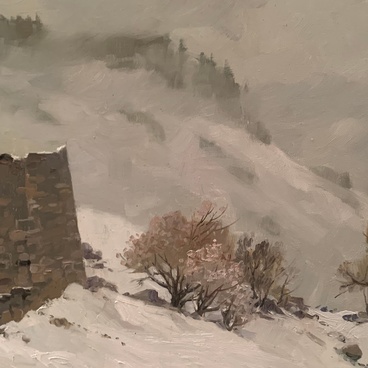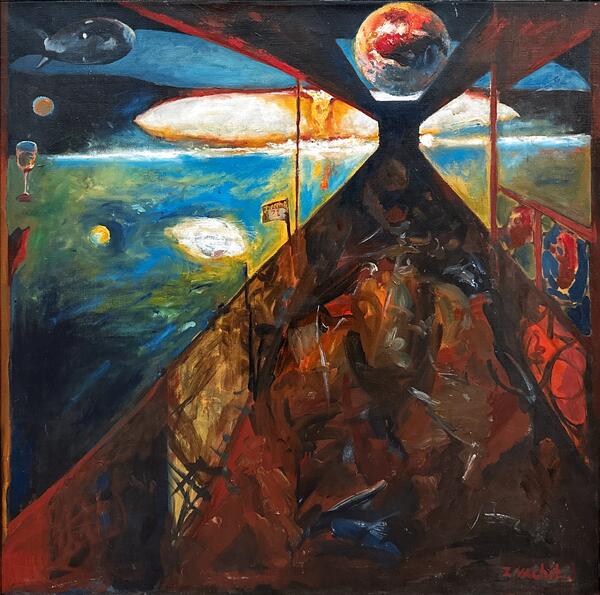Vakhit Zauraev painted the picture Survived tower in 2004. He created it in oil on the canvas. The master devoted his canvas to military events on the territory of Chechnya.
Almost the entire space on the picture is occupied by rocky surface. In the upper part of the rock is an oval aperture. Through the aperture is a view to a semi-destroyed tower. Such towers were often built in the mountains for residence and fortification purposes in Middle Ages. The erections had several floors. And they gradually narrowed aloft. Over time tower became a symbol of history and culture of the Chechen nation.
The tower on the painting has survived regardless all blows. Behind it in the distant view is an integral tower complex. It is elucidated with bright sun rays. The tower complex is a symbol of revival. It implies a hope of a brighter future of the Chechen Republic.
It its stylistics, the work of Vakhit Zauraev is close to symbolism. The master became one of the first Chechen avant-garde artists. The experts from the National Museum of the Chechen Republic noted that the peculiarity of his creativity is a ‘synthesis of Chechen spirit and European modernist esthetics’. In his early works the influence of expressionism and symbolism is noticeable. In his later creativity he reverted to conventional picturesque styles. ‘In his canvasses either the motives of despair, grief and protest show through or a trembling before the riddles of the Universe is felt or love for life triumphs’.
Regretfully, the considerable portion of the works of Vakhit Zauraev perished during military operations. In November 1994 his personal exhibition was running in the Union of Artists of the Chechen Republic. When the hostilities began, many paintings were burnt. For the time being a collection of works of Vakhit Zauraev that the master himself gifted to the museum is kept with the holdings of the National Museum of the Chechen Republic. The picture Survived tower is in the permanent exhibition. It is always open for viewing.
Vakhit Zauraev was born in 1952. At that time his family was deported to Kazakhstan. In 1957 he together with his relatives returned to his historical homeland to the village of Alkhan-Yurt where he currently lives.
Almost the entire space on the picture is occupied by rocky surface. In the upper part of the rock is an oval aperture. Through the aperture is a view to a semi-destroyed tower. Such towers were often built in the mountains for residence and fortification purposes in Middle Ages. The erections had several floors. And they gradually narrowed aloft. Over time tower became a symbol of history and culture of the Chechen nation.
The tower on the painting has survived regardless all blows. Behind it in the distant view is an integral tower complex. It is elucidated with bright sun rays. The tower complex is a symbol of revival. It implies a hope of a brighter future of the Chechen Republic.
It its stylistics, the work of Vakhit Zauraev is close to symbolism. The master became one of the first Chechen avant-garde artists. The experts from the National Museum of the Chechen Republic noted that the peculiarity of his creativity is a ‘synthesis of Chechen spirit and European modernist esthetics’. In his early works the influence of expressionism and symbolism is noticeable. In his later creativity he reverted to conventional picturesque styles. ‘In his canvasses either the motives of despair, grief and protest show through or a trembling before the riddles of the Universe is felt or love for life triumphs’.
Regretfully, the considerable portion of the works of Vakhit Zauraev perished during military operations. In November 1994 his personal exhibition was running in the Union of Artists of the Chechen Republic. When the hostilities began, many paintings were burnt. For the time being a collection of works of Vakhit Zauraev that the master himself gifted to the museum is kept with the holdings of the National Museum of the Chechen Republic. The picture Survived tower is in the permanent exhibition. It is always open for viewing.
Vakhit Zauraev was born in 1952. At that time his family was deported to Kazakhstan. In 1957 he together with his relatives returned to his historical homeland to the village of Alkhan-Yurt where he currently lives.




